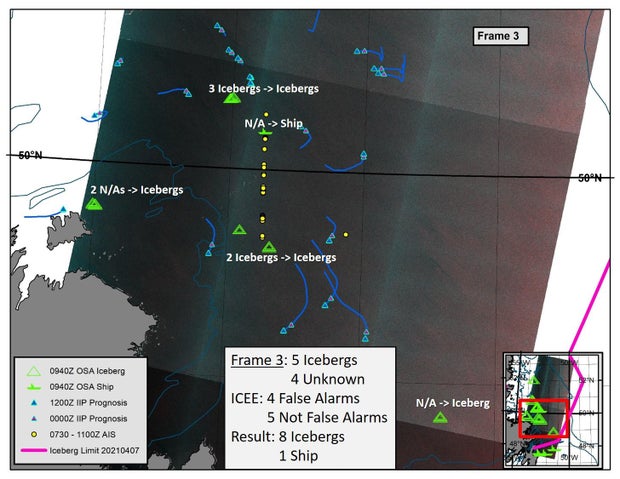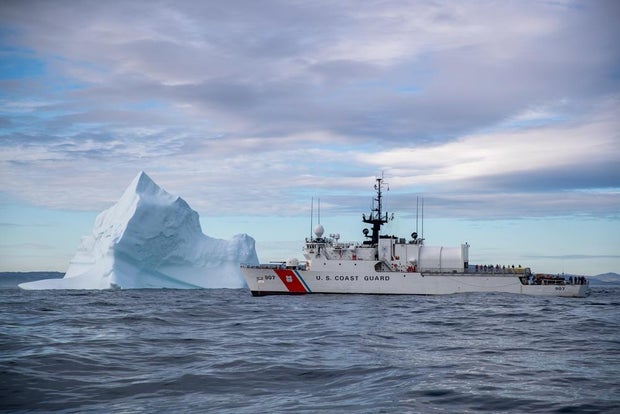[ad_1]
It was the “unsinkable ship” until finally it was not.
10 minutes before the maiden voyage of the Titanic ended in calamity, a radio operator aboard the close by SS Californian signaled that there was an iceberg in the ship’s route. The warning was disregarded, and the huge collision that followed value more than 1,500 lives, prompting a wave of maritime improvements: sonar and radar navigation features, lifeboat drills and the generation of the Worldwide Ice Patrol (IIP.)
Now, 110 yrs immediately after the sinking of the Titanic, the U.S. authorities is building a new know-how that’s intended to detect and report icebergs to the maritime neighborhood.
“Operation Titanic,” spearheaded by the Division of Homeland Security’s Science and Technology Directorate, will fuse satellite-based mostly radar imagery with ship reporting techniques to empower the U.S. Coastline Guard to establish glacial masses throughout the North Atlantic Ocean in real time.
Supplied by U.S. Coast Guard
Floating icebergs like the just one the Titanic struck on April 15, 1912, still pose navigational hazards now for ships, oil rigs and navy assets, says Kathryn Coulter Mitchell, the DHS senior official performing the obligations of the under secretary for science and know-how, advised CBS Information.
“The Titanic actually struck the iceberg at a latitude equal to the Massachusetts area,” Coulter Mitchell reported. “Those people of us in this mission place don’t often notice just how significantly south, how widespread the iceberg mission is.”
The 16-human being IIP is funded by 17 nations bordering the trans-Atlantic, but is operated by the U.S. Coast Guard through ice period, from February as a result of July.
The patrol initially relied on cutters deployed by the U.S. Coastline Guard to study icebergs but switched to plane checking following World War II. Currently, the IIP pilots 9-day plane missions every single two weeks.
Supplied by U.S. Coastline Guard
“Operation Titanic” will mark a “entire departure from [U.S. Coast Guard’s] many a long time of traveling preset-wing aircrafts to locate icebergs,” said Coastline Guard Commander Marcus Hirschberg with the Worldwide Ice Patrol. .
Offered by U.S. Coastline Guard
“Aerial ice reconnaissance” routinely adds up to far more than $10 million in once-a-year costs for the U.S. Coastline Guard. Outside of the cost tag, C-130J aircrafts that fly bi-weekly missions – around 500 aircraft hours for every season – are also the U.S. Coastline Guard’s most remarkably sought immediately after aviation belongings.
“We are going to get a good deal much more bang for our buck the moment we can use all those aircraft hrs for disaster reaction, counterdrug operations, migrant operations and other regions,” Hirschberg additional.
The U.S. authorities has invested $4 million in “Operation Titanic” to date, with money drawn from the Science and Technologies Directorate’s Research, Progress and Innovation fund.
And even though equivalent systems are at the moment made use of by the U.S. government in rescue missions and flood reaction, the new satellite technology – which will attract photos from the European Room Agency satellites, U.S. business suppliers and Canada’s RADARSAT Constellation – will be the initial of its variety to obtain international satellite info.
The satellite-dependent radar imagery continues to be fully operational in darkish, overcast circumstances that typically stop typical plane operations. Hirschberg identified as it a “sport-changer for forecasting the year.”
“When the Coastline Guard arrived to us with this, the hope was to get over the problems with [technology] that is immune to darkness and overcast, so we can see further upstream of the transatlantic delivery traces than we at any time have been before to issue lengthier-expression predictions,” Coulter Mitchell reported.
“For forecasting, we’re searching at icebergs that are way far North that we are unable to achieve with aircrafts, even traveling from St. John’s Newfoundland,” claimed Hirschberg.
“A great deal of periods there is certainly a mechanical challenge with the airplane, inclement weather conditions, or we are not able to get the hangar door open because of substantial winds. So we do drop a good deal of alternatives to fly,” he added.
Glaciers in areas of the North Atlantic are melting so speedily that modifications can be viewed from place. The hottest “Arctic Report Card,” published by the National Oceanic and Atmospheric Administration (NOAA), discovered the region warms 2 times as quickly as the relaxation of the Earth, ensuing in the fast reduction of ice go over.
“We see so considerably season-to-season variability,” Hirschberg told CBS News. “In 2019, we experienced 1,500 icebergs go south of 48° North latitude – about where the Titanic sank. In 2020, we had a solitary iceberg pass that restrict.”
U.S. Coast Guard officers foresee applying satellite photos will help the branch navigate adjustments brought on by a reworking local weather.
The Intercontinental Ice Patrol is slated to exam-operate “Operation Iceberg” for two yrs, commencing in 2023 just before launching the method.
[ad_2]
Supply url












More Stories
5 Ways to Boost Data Security on the Cloud
Apple Black Friday Sales, iPhone 15 Pro rumors, Device Buying Guide
How Businesses Can Overcome Cybersecurity Challenges